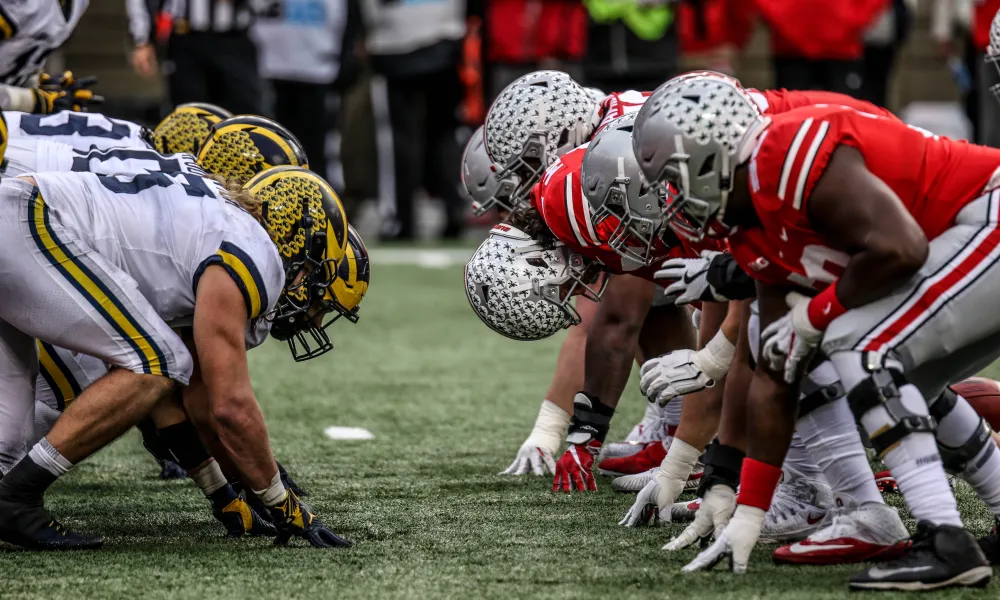Inside the Huddle: Strategies for Success in NCAA Football Recruiting

NCAA football recruiting is a multifaceted process that requires coaches to employ a variety of strategies to identify, evaluate, and ultimately secure commitments from top high school prospects. In this detailed exploration, we’ll delve into the intricacies of NCAA football recruiting, examining the key strategies and tactics used by coaches to navigate the competitive landscape and build successful programs.
Recruiting Landscape
The recruiting landscape in NCAA football is a dynamic and ever-evolving environment shaped by various factors such as advancements in technology, changes in NCAA regulations, and shifts in cultural and social norms. Gone are the days when recruiting was confined to local and regional scouting; today, it has become a national and even international pursuit. Coaches have access to a vast pool of talent thanks to the proliferation of recruiting services, scouting combines, and digital platforms. This expansion has transformed recruiting into a highly competitive and data-driven endeavor where coaches must navigate through a multitude of options to find the best fit for their programs.
The Evolution of Recruiting
NCAA football slot recruiting has undergone significant changes over the years, shaped by advancements in technology, alterations in NCAA regulations, and shifts in cultural and social norms. The process, once confined to local and regional scouting, has expanded into a national and even international endeavor. Coaches now have access to a vast pool of talent, thanks to the proliferation of recruiting services, scouting combines, and digital platforms. These changes have transformed recruiting into a highly competitive and data-driven pursuit.
The Importance of Relationships
Relationship-building lies at the heart of NCAA football recruiting. Coaches must establish trust, rapport, and mutual respect with recruits and their families to navigate the recruiting process successfully. These relationships extend beyond the field and often endure long after a player’s college career has ended. Coaches who prioritize relationship-building not only enhance their chances of securing commitments from top prospects but also lay the foundation for a cohesive and supportive team culture.
Strategies for Success
In the competitive realm of NCAA football recruiting, coaches employ a variety of strategies to identify, evaluate, and secure commitments from top high school prospects. One key strategy is targeted talent identification, where coaches meticulously analyze prospects to determine their potential fit within their program’s culture and playing style. Strategic positional recruiting is another critical aspect, where coaches allocate resources to address specific positional needs and roster deficiencies. Personalized pitching plays a significant role as well, as coaches tailor their recruiting pitches to resonate with each individual prospect, highlighting how their program can help them achieve their academic, athletic, and personal goals.
Building a winning culture is essential for attracting top talent, as recruits are drawn to programs with a history of success and a positive team environment. Leveraging technology and data analytics allows coaches to streamline the recruiting process and gain valuable insights into player performance and potential. Embracing social media and digital platforms facilitates direct communication with recruits and enables coaches to showcase their program’s culture and accomplishments to a broader audience. By employing these strategies effectively, coaches can position their programs for sustained success in NCAA football recruiting.
Targeted Talent Identification
Effective recruiting begins with targeted talent identification. Coaches must possess a keen eye for talent and a deep understanding of their program’s needs and priorities. They must identify prospects who not only possess the physical attributes to excel on the field but also align with the program’s values, culture, and playing style. Coaches rely on a combination of scouting techniques, film analysis, and in-person evaluations to assess prospects and determine their potential fit within the program.
Strategic Positional Recruiting
In addition to targeting talent, coaches must strategically recruit to address positional needs and roster deficiencies. They must assess their team’s strengths and weaknesses and allocate recruiting resources accordingly. Whether it’s bolstering the offensive line, fortifying the secondary, or finding a dynamic playmaker at the skill positions, coaches must have a clear vision for how each recruit fits into their team’s long-term strategy and success.
Personalized Pitching
Each recruit is unique, with their own aspirations, motivations, and preferences. Coaches must tailor their recruiting pitches to resonate with each individual prospect, highlighting how their program can help them achieve their academic, athletic, and personal goals. Personalized pitches that speak to a recruit’s interests, values, and aspirations are more likely to forge a deep connection and garner genuine interest from prospects.
Building a Winning Culture
Recruits are drawn to programs with a winning culture and a track record of success. Coaches must emphasize the values of hard work, discipline, accountability, and teamwork that underpin their program’s culture. They must create an environment where recruits feel valued, supported, and empowered to reach their full potential both on and off the field. A winning culture not only attracts top talent but also fosters a sense of camaraderie and pride among players and coaches alike.
Leveraging Technology and Data Analytics
Technology plays an increasingly vital role in NCAA football recruiting, enabling coaches to streamline the process and gain insights into player performance and potential. Coaches leverage data analytics, video analysis software, and recruiting databases to identify prospects, track their progress, and assess their suitability for the program. Advanced metrics such as player efficiency ratings, athletic measurables, and performance analytics provide coaches with valuable insights into a recruit’s strengths, weaknesses, and potential fit within the program.
Embracing Social Media and Digital Platforms
Social media and digital platforms have become indispensable tools for NCAA football recruiting, allowing coaches to connect with prospects, engage with fans, and showcase their program’s culture and accomplishments. Coaches use platforms such as Twitter, Instagram, and TikTok to share program updates, highlight player achievements, and provide behind-the-scenes glimpses into life on campus. Social media facilitates direct communication between coaches and recruits, enabling coaches to build relationships and convey their recruiting pitch in a more personal and interactive manner.
Conclusion
In conclusion, NCAA football recruiting is a dynamic and multifaceted process that requires coaches to blend strategic planning, relationship-building, and talent evaluation to build successful programs. By understanding the evolving recruiting landscape, identifying strategic priorities, personalizing their recruiting pitches, fostering a winning culture, leveraging technology and data analytics, and embracing social media and digital platforms, coaches can position their programs for sustained success on and off the field. While recruiting is inherently competitive and unpredictable, coaches who employ these strategies consistently and effectively increase their chances of attracting top talent, building winning teams, and achieving excellence in the highly competitive world of college football.
![]()

NFL Draft Diamonds was created to assist the underdogs playing the sport. We call them diamonds in the rough. My name is Damond Talbot, I have worked extremely hard to help hundreds of small school players over the past several years, and will continue my mission. We have several contributors on this site, and if they contribute their name and contact will be in the piece above. You can email me at nfldraftdiamonds@gmail.com
